You’re sitting down to write out the new phase of your team’s training program…
- What is your process?
- What are the underlying training principles you reflect on to create the sheet your athletes will use?
- Where do these principles come from?
When you are determining what your athletes and their sport require, you are tapping into your belief system about what training is.
Every thing that you put in your program is based on underlying training principles that you believe in.
There is (or should be) a reason these things are in your program, as you are designating them as important once you choose to write them on the sheet. The things I am referring to can be exercises, reps, sets, exercise order, testing numbers, and words. You then carry out these things with explanations, cues and your behavior as a coach.
These things all come from your perception of what training is, in relation to exercise selection, how an exercise should be performed, what a strength and conditioning coach should be, and what the athlete is expected to do. It is the lens through which you view training.
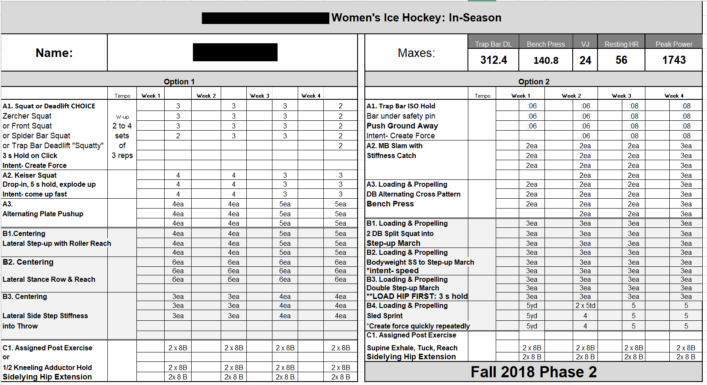
Belief Systems
A belief system is a set of principles or tenets which together form the basis of a religion, philosophy, or moral code.
In the context of this article, your strength and conditioning coaching belief system is formulated by your principles of sport training and exercise. These interconnected set of principles organize and create inherent qualities of mind and character in relation to behavior (as a coach).
Another definition for a belief system is a cognitive framework that helps to predict potential outcomes, thus assisting to better regulate our emotional disposition to an anomaly. Therefore, your training belief system includes what you interpret as important in the weight room, the interventions you create for a desired outcome in training, and your emotional and behavioral response to training/a trainer that may be different from your own style.
What you view as important in the weight room are your underlying principles as a coach. You use these principles for your program analysis, design, and coaching.
How you feel towards something that deviates from what is normal, standard, or expected and how you respond to it, taps into your system of beliefs and underlying personality structure.
Any time you get into thoughts about, is this good or bad and how you respond to what is good or bad, you are tapping into your belief systems.
- Is this good or bad exercise selection?
- Is this good or bad exercise technique?
- Is this good or bad program design?
Your beliefs about what is good or bad can be molded through personal experiences and can also be provided to you. Your own training experience, your previous strength and conditioning coaches, your mentors (people in positions of influence), internships, and reading material of choice can formulate your perception of what training is and is not. Your beliefs can also be provided to you by academic institutions, modality systems, or social systems.
There are pros and cons to belief systems. The pros are that they create a cohesive narrative, assist in decision making, and allow you to have opinions about what is good vs bad.
The cons are that they can blind you and bias you in our decision making.
The pros and cons can be elaborated within a spectrum of rigidity and permeability within our belief systems. If we are too rigid, we view our opinions as facts then protect and justify these beliefs possibly creating conflict and restricting personal growth.
If we are too permeable then nothing matters, we have no values, and can be swayed in our opinions with every new thing we are told. If you are too permeable or have no belief system at all, when you experience an anomaly you don’t have a mode of being, in which you will experience anxiety.
There is utility in belief systems and anxiety. A belief system provides you with a way to behave when you experience an anomaly and having a belief system that resonates with you facilitates purpose and meaning. Experiencing anxiety in relation to your belief systems will allow you to transform and become better, it is what you are supposed to face.
Your decision making process in creating a training program is a reflection of your beliefs about training. The training program and how it is implemented becomes your athletes’ belief system towards training. The environment you create for the people on the team provides a structure for how you want them to regulate themselves. There are three elements we will explore based on our training belief systems:
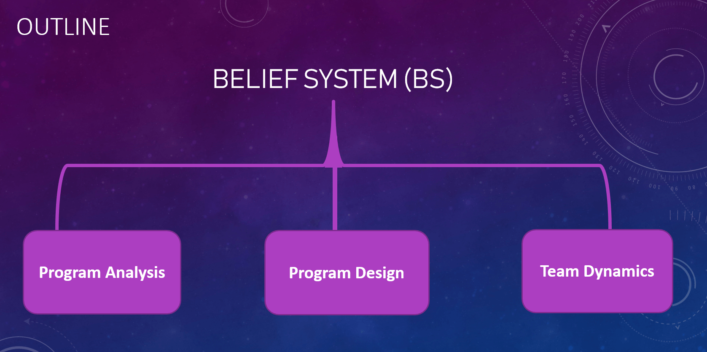
- Program analysis is your belief system towards training
- Program design is the belief system you provide to athletes
- Program Team Dynamics/Environment is the culture you create within a team setting
Program Analysis:
My Belief System Towards Training
When I examine the elements or structure of a training program I am going to design, I think about three areas: specificity vs variation, questioning is I am starting with an exercise or starting with an intent, and creating a learning environment.
1. Specificity vs Variation
In relation to specificity and performance based activity, I place my training values less with having a reductionist approach of breaking down biomechanics and energy systems to attempt to mimic, and more towards skill acquisition and motor learning strategies.
Skill acquisition is what I think an athlete should do well vs. what I don’t care about in the weight room.
Within the weight room setting, what do I think athletes need to be able to do?
Once I choose what skills I think they should acquire, what methods and tactics am I going to select in order to teach those skills?
I want athletes to perform these skills at a high level which is going to be less variable and more predictable. I then have to question my biases. I can’t fool myself into thinking that the weight room is the only thing that matters in relation to athletic performance and that the activities I select have direct transfer to sport.
Including specificity into my program design will also include deciding what I want the athletes to BELIEVE is important; these will be my training principles and values.
In relation to variation, I place my training values on exposing athletes to various positions and movements that they don’t usually experience. I believe that including variation is a major health component of training. Variation will assist in dispersing load to different tissues and create long term sustainable training strategies.
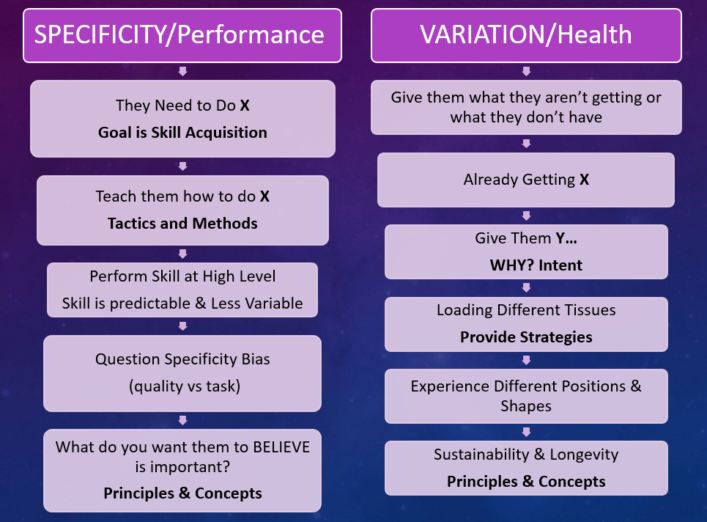
Overall, I BELIEVE that both are important; I place value on both skill acquisition and progressive overload (specificity) and exposure to different positions and novelty (variation) within the weight room.
2. Starting with the exercise or start with the intent?
Here is where I take time to question my own training beliefs.
Am I starting with an exercise, or the intent of the exercise?
For example, when I am filling out my programming template A1, A2, A3, am I thinking about where I am going to fill in the squat, bench press, clean, and deadlift exercise or am I starting with an intent?
If my intent is to teach athletes how to absorb force and create force against gravity with sagittal plane competency, then the squat exercise as a good method for that intent. If I write ‘squat’ on my program sheet, as a thing, I want there to be a rationale coinciding with a principle and value.
Am I associating an exercise with a specific quality?
For example, am I selecting the back squat exercise because I associate that with the quality of strength? That association may be placed within a biased belief system of what I believe strength is and why it is important for an athlete to develop for improved on-field performance.
This questioning allows me not to be married to a specific exercise and allows me to explore my creativity.
The intention also includes strategies: how do I want an athlete to perform and exercise and how do I want them to feel about it.
There is no absolute way to lift weights, there are just strategies.
For example, I can select the squat pattern for an exercise, however I can vary in where I place the load or the cues (focused attention) I used in relation to how I want them to think about how their hips and knees should move, or if they should have focus on an internal or external reference.
- Are those strategies in the best interest of the athletes or are they the only ones that I know?
- Are these strategies sustainable?
- Do they provide long term learning opportunities or short term gains?
- What’s my plan for progression of these strategies?
- Progress by maintaining strategies under load
- Increase the amount of strategies
- Active vs Passive Strategies
3. Creating a learning environment
Lessons will provide the acquisition of knowledge or skills through experience, study, or by being taught.
So, what do I want to teach the athletes I work with?
I create lessons within training sessions in relation to the specific skills I want to teach athletes. I then reinforce these lessons that encompass my training principles with everything I do within that training session.
The lesson is initiated by discussing it with the team before the session to focus their attention towards it and reinforced after the session with questions and archetypes of execution observed from the athletes.
Program Design:
Facilitate Growth of My Belief System for Athletes
You may believe your program will lead to the desired outcome, but now you need to create a belief system for your athletes so they believe the same thing. You will need to consider how to make your beliefs about training, their beliefs.
This not only applies to their current training program, but also their overarching lens for how they perceive exercise. Perception can be a powerful mediator in the success of your program and their development of future exercise habits.
You must have things that are important to you and know that they will become important to your athletes. There is responsibility within this.
- What do you want them to value?
- How are you going to make your training beliefs resonate with your athletes?
- How do you want them to use these principles when you are not with them or in their future exercise habits?
The overall goal is to provide them with a mode of being/ how you want them to behave when they experience an anomaly.
This can be both when they are training without you or after they graduate. You want the athlete to have an understanding of what was important to you and make it important to them.
How do I want athletes to think about training? The belief system you provide them will be how they think about exercise for the rest of their lives.
- Do they only associate exercise with sport?
- Did you teach them anything that they can maintain?
- Did they LEARN how to train and take care of themselves?
- Did they learn how to appreciate the process and the virtues of character that come with exercise?
- Can they apply what they learned to establishing responsibility for their own health and fitness?
Putting it Together
When I am creating a program to lead athletes towards a desired outcome I have a three step process:
- I use my training principles to determine what I think is important and what lessons I want to teach the athletes.
- I create exercises to match my training principles and that reflect the intention of the desired outcome.
- I decide what strategies I want the athletes to execute the exercises with.A) This includes providing autonomy and options for strategies or choice of tool. Once a level of experience and understanding is attained, allowing the athlete to be involved in the process will create a sense of control and potentially elicit more effort. Success with process goals is strongly dependent upon effort. Their input and choice of tool can be a valuable aspect of proper execution of a pattern. Choice is also involved in the process of guided discovery which allows athletes to begin figuring it out things for themselves. Guided discovery can help create curiosity and meaningfulness in a belief system.B) I also manipulate by coaching tactics within this step. I may need to utilize an adaptive personality, make decisions on cueing, and provide different types of feedback based upon the athlete’s personality and temperament. How do I deliver information? What do I celebrate as important? For example, if I celebrate a maximal load lifted, then I am creating a belief in the athletes that maximal load lifted is valued. However, if I choose to celebrate a teammate positively encouraging another teammate or being thoughtful during an exercise, that establishes the behavior as valued.
The process of designing a training program:
Creating a learning environment through principles and lessons
I use my 4 training principles that I have written out to determine what I deem to be important. My training principles include:
- Proximal structure position influences movement of distal structures
- Expose the body to positions and shapes it struggles to achieve
- Athletic skill acquisition includes the ability to transition from leg to leg
A) Centering (shifting) & Dissociation (rotating)
B) Loading & Propelling - Growth is experience in various types of hard work
A) Physical, Awareness, Humility & Gratitude, and Perspective
I use these principles to create a learning environment. Each principle involves lessons that I want to teach the athletes.
A lesson will help regulate training sessions and move the athlete towards a way to behave. A lesson will guide my exercise selection choice and strategies for execution that will be reinforced throughout the session.
Lessons can also create excitement and meaningfulness.
“Principles are few. The man who grasps principles can successfully select his own methods. The man who tries methods, ignoring principles, is sure to have trouble.” – Ralph Waldo Emerson
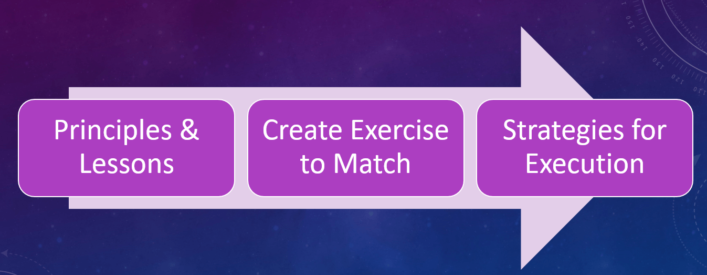
An Example of this Process
- Choose the lesson of transitioning from leg to leg which is an important concept for all sporting activities such as running, skating, throwing a ball, and change of direction.
- Exercises that will match this intent involve lateral stance activities, push mechanic drills, and change of direction drills.
- Strategies for execution involve teaching and reiterating centering and dissociation concepts. Centering involves frontal plane mechanics and the ability to shift yourself over a leg. Dissociation involves rotating a thorax over a pelvis which is important for acceleration, change of direction, and shooting. I choose exercises relating to this lesson and sequence them together to reinforce the concepts (video for pairing exercises within this lesson).
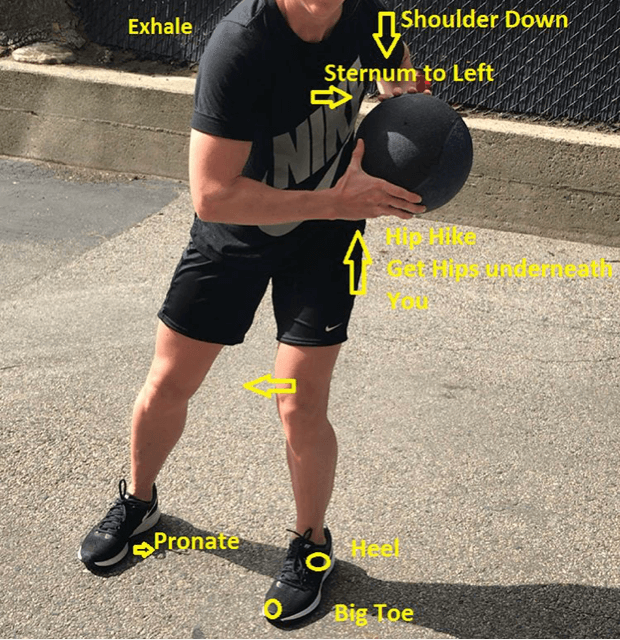
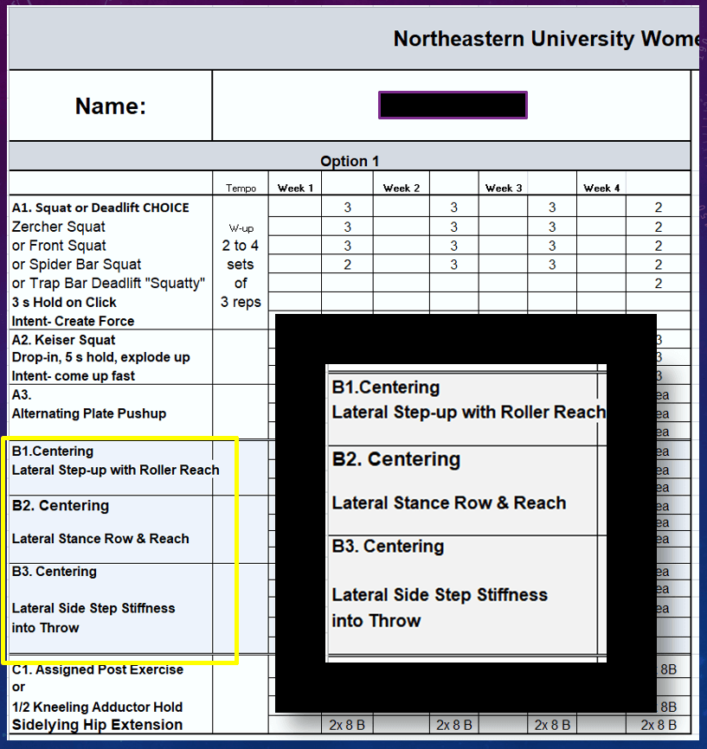
Program Team Environment
A key influence on the desired outcome of the program design is the interaction between coach and athlete, as well as athlete to athlete. The human experience needs to be facilitated for belief in the program, team, and meaningfulness in sport.
The purpose of sport and the reason for training can’t be assumed to be obvious. Make the purpose and ‘why’ clear. Plan the transfer of information and put forth effort to communicate this information.
My fourth training principle is growth and experience in various types of hard work; this is implemented in what I expect out of the athletes.
This is including a psycho-emotional variable into programming for team environments. A coaching staff has the ability to manage total loads inclusing as physical, cognitive, and emotional loading. You can reduce anxiety through creating positive relationships, team culture, teaching values such as self- compassion, gratitude, humility, and respect in order to improve overall team performance.
- Do they enjoy coming to the training center every day?
- Is the environment welcoming, supportive, and non-threatening?
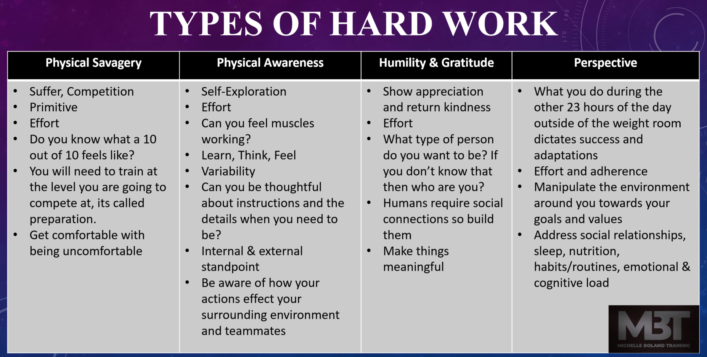
Installing a belief system relates to both a cognitive framework towards physical exercise but also personal qualities of character. A team environment based on a structured value system will allow them to have a mode of being when responding to times of challenge. Can they behave with these values during times of losing?
The values and implementation of gratitude, respect, and humility can carry over to team success and personal growth. You have the ability to create a cognitive framework that sets them up to make decisions putting them on a positive trajectory. This is the usefulness of sport and being responsible from a positive of influence.
- Do you only value winning? Do you only celebrate winning?
- Do you discuss virtues of character and acknowledge them?
- What are associating as important? Winning or qualities of character?
Conclusion: Discover Your Belief System
Discover your belief system by articulating what you already do. Write down your training principles and values. However, be willing to allow them to change.
Ask yourself the following questions:
- What is important to you in training? What are your training principles?
- What are they good for?
- Creating a cohesive message and language with your athletes
- Creating a framework to which athletes regulate themselves
- What are they leaving you blind to?
- Expose yourself to a different training belief systems and create your own filter

The sweet spot to adapting your belief system (shaping how you feel and respond to anomalies) is to be curious and interested.
Too bored or too threatened can impact how your belief systems are adapted or reinforced.
Your ability to adapt and grow your beliefs relates to the amount of anomaly you are ready for.
It is our job as strength and conditioning coaches to determine what matters. Typical program design variables include exercise selection, frequency, exercise order, rest periods, volume, training loads, and repetitions.
However, belief systems supersede decision making. Program design is deciding what you should care about vs. what you should care less about. What you care about then becomes what your athletes care about and how they will view training and exercise.
To watch my full presentation about this topic at the Holy Cross Sport Performance Conference, CLICK HERE
About the Author

Michelle Boland
- Director of Education at Pure Performance Training (Needham, MA)
- Owner of Michelle Boland Training, LLC
- Previous Strength and Conditioning Coach at Northeastern University (Boston, MA)
- Exercise Physiology and M.S. Strength and Conditioning at Springfield College
- S. Nutrition at Keene State College
- Follow on Instagram @mboland18
References
- Cupples, Z. Human Matrix. 2018. https://zaccupples.com/
- Davidson, P. Rethinking the Big Patterns. 2017. drpatdavidson.com
- Glazier, P.S. (2017). Towards a Grand Unified Theory of sports performance. Human Movement, 56, 139-156.
- Hartman, B. The Intensive II. 2018. billhartman.net
- Kiely, J. (2018). Periodization Theory: Confronting an Inconvenient Truth. Sports Med, 48, 753-764.
- Rokeach, M. (2015). The Open and Closed Mind: Investigations into the nature of belief systems and personality systems. Williams & Wilkins; New York, NY.
- Rutjens, B. & Brandt, M. (2019). Belief Systems and the Perception of Reality (Currents Issues in Social Psychology). Routledge; New York, NY.
- Young, D. (2014). How to think about exercise. The school of life, Picador: New York, NY.
- List of Continuing Education Courses Attended. http://www.michelleboland-training.com/about-me/
